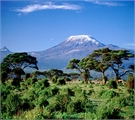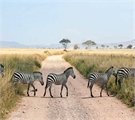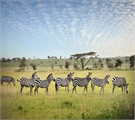Best Time to Climb Mount Kilimanjaro
Are you ready to conquer the majestic Mount Kilimanjaro? Planning your climb to Africa's highest peak involves careful consideration of the timing. As you embark on this thrilling adventure, choosing the best time to climb Mount Kilimanjaro can significantly enhance your experience. In this guide, we'll delve into the seasons, weather patterns, and crucial factors to help you make an informed decision.
Understanding Mount Kilimanjaro Climbing Seasons
Mount Kilimanjaro, a dormant volcano in Tanzania, offers diverse climbing experiences throughout the year. The primary climbing seasons are divided into the dry season and the wet season. Each season has its unique characteristics, influencing the difficulty and beauty of the climb.
Best Time to Climb Mount Kilimanjaro
Determining the best time to climb Mount Kilimanjaro depends on various factors, including weather, temperature, and personal preferences. The prime window for climbing is during the dry seasons, providing optimal conditions for a successful ascent. Let's delve into the specifics of the best time for your Kilimanjaro adventure.
Dry Season Climbing Advantages
Climbing Mount Kilimanjaro during the dry season, typically from late June to October and December to February, offers several advantages. The skies are clear, providing breathtaking views of the surrounding landscapes. Trail conditions are more favorable, facilitating a smoother trekking experience.
Increased Visibility and Stunning Views
The absence of rain and clouds during the dry season ensures unparalleled visibility. The snow-capped summit, lush landscapes, and unique flora become a mesmerizing backdrop, creating a truly memorable climb.
Better Trail Conditions and Trekking Experience
Dry trails contribute to a more stable and comfortable trek. Navigating the routes becomes easier, reducing the risk of slips and falls. This, combined with pleasant temperatures, enhances the overall enjoyment of the climb.
Wet Season Challenges
While the wet season (March to May and November) has its allure, it presents challenges that climbers must carefully consider. Heavy rainfall can create muddy and slippery trails, posing difficulties in navigation. Safety concerns, such as the risk of avalanches, are heightened during this period.
Potential Obstacles and Safety Concerns
The wet season brings about a series of challenges, including slippery paths, reduced visibility, and the potential for rockfalls. Climbers need to be well-prepared for these obstacles and exercise caution during the ascent.
Managing Expectations for a Wet Climb
Choosing the wet season requires a realistic understanding of the challenges involved. Proper gear, experienced guides, and a positive mindset are essential to overcoming the obstacles presented by the wet conditions.
Peak Seasons and Crowd Dynamics
Regardless of the chosen climbing period, adequate preparation is key to a successful and enjoyable Kilimanjaro climb. Let's explore some tips for gearing up based on the season you plan to conquer this iconic peak.
Exploration of the Peak Climbing Seasons
Peak climbing seasons usually coincide with the dry months, attracting more adventurers seeking ideal conditions. The months of July and August, as well as January and February, see a surge in climbers eager to conquer Kilimanjaro.
Discussion on the Crowd Factor and Its Impact
While peak seasons offer optimal weather, they also mean more crowded trails and campsites. Managing expectations regarding the number of fellow climbers is essential for those seeking a more solitary experience.
Balancing Between Peak and Off-Peak Times
Consideration of off-peak times, such as early June and late November, allows for a less crowded climb. Choosing a less popular time can provide a more intimate connection with nature and a quieter trekking environment.
Fitness and Health Precautions
Ensuring physical fitness and prioritizing health precautions are vital elements of preparing for a Kilimanjaro climb. Tailor your approach based on the season to maximize safety and well-being.
Preparing for Different Climbing Periods
Regardless of the chosen climbing period, adequate preparation is key to a successful and enjoyable Kilimanjaro climb. Let's explore some tips for gearing up based on the season you plan to conquer this iconic peak.
Tips for Preparation During the Dry Season
- Hydration Essentials: In the dry season, staying hydrated is crucial. Ensure you carry an ample water supply and drink regularly to combat the effects of high-altitude trekking.
- Sun Protection: With clear skies, the sun can be intense. Pack and apply sunscreen, wear sunglasses, and use a wide-brimmed hat to protect yourself from harmful UV rays.
- Layered Clothing: While daytime temperatures are warm, nights can be chilly. Pack layered clothing to adjust to temperature variations during the climb
Strategies for Tackling Challenges in the Wet Season
- Waterproof Gear: Invest in high-quality waterproof gear, including rain jackets, pants, and backpack covers. Keeping yourself and your equipment dry is essential during the wet season.
- Sturdy Footwear: Choose waterproof and slip-resistant hiking boots. The trails can become muddy, and proper footwear is crucial for stability and comfort.
- Positive Mindset: Embrace the challenges of the wet season with a positive mindset. Be mentally prepared for the obstacles and focus on the unique beauty the rain brings to the landscape.



Tips on Physical Preparation for Varying Weather Conditions
- Cardiovascular Training: Improve cardiovascular endurance through regular cardio exercises to acclimate to the demands of high-altitude trekking.
- Strength Training: Include strength training to build muscle endurance, especially for challenging terrains.
- Altitude Simulation: Consider altitude simulation training to prepare your body for reduced oxygen levels at higher altitudes.
Health Precautions to Consider Based on the Chosen Climbing Time
- Hydration Focus: In both dry and wet seasons, prioritize hydration to combat the effects of altitude and physical exertion.
- Weather-Appropriate Clothing: Pack clothing suitable for the chosen season to ensure comfort and prevent weather-related health issues.
- Altitude Sickness Awareness: Understand the symptoms of altitude sickness and acclimatize slowly, especially during the ascent.
Choosing the best time to climb Mount Kilimanjaro is a crucial decision that shapes your entire adventure. Whether you opt for the panoramic views of the dry season or the unique challenges of the wet season, careful planning and preparation are essential. Embrace the journey, respect the mountain, and savor the accomplishment of reaching Uhuru Peak.




